Today, many more babies have flat spots on their heads than 20 years ago. In fact, it is now common to see babies out in public wearing orthotic helmets and to hear stories about their courses of physical therapy. Diagnosis of positional plagiocephaly/brachycephaly and often-concurrent torticollis, two mostly preventable conditions, is on the rise. What can we as parents, caregivers, and medical practitioners do to reduce the risk of these diagnoses?
Bring Recess Back!
What comes to your mind when you read the word “recess”? Many will recall elementary school days of spending time on a playground with your friends running, jumping, exploring, etc. It was the best part of the day!
Play: 6 to 8 Months
Babies 6 to 8 months continue to move, play, and grow at an amazing rate! At times, it seems as though they are learning something new every day! Many of the same principles that we discussed in the post about play with your 4 to 6 month old continue to apply. Here are 5 new tips to consider:
SAFETY: A moving baby who puts everything into his mouth needs to be watched all the time because he can quickly swallow small objects or creep into unsafe places. Babies are not able to understand about danger. Lock away unsafe objects or put them high out of reach. Many experts advise to use the TP Rule: if an object can fit through the hole in a toilet paper tube, then it is too small for a child 3 and under to play with. If there are older siblings in the home, please teach this to them as well so they can be an active participant in determining what toys can be out when baby is playing. PLEASE ENSURE THE SAFETY OF YOUR BABY by childproofing! Get down on the floor, crawl around, and see what your little explorer could find!
Social: Time for play dates! Start early – this is as much for you as it is for your baby! People are much more interesting than things and babies love to see other little people that look like they do! You and baby will also create lasting friendships.
Stranger/Separation Anxieties: Expanding baby’s social circle is important but be aware of his sensitivity when around strangers and when separating from mom (stranger anxiety and separation anxiety). If you do have to leave, make sure you still say good bye and explain that you will be back.
Simple: Babies don’t need fancy toys! They can be happy playing with a set of measuring cups, exploring plastic bowls or a spoon, etc. The main point to remember is offering varying sizes, shapes, colors and textures. Remember, baby is not impressed by labels or price tags!
Sun, Sand, Snow: It’s time to get outdoors! Baby is now old enough to be outside with baby safe sunscreen so spend time enjoying it. Watch the trees moving in the wind and try to find birds, flowers, doggies, and other people. Talk about you are finding as you explore the environment! Baby loves to hear the sound of your voice and the more you speak in a happy, sing-song voice, the more your baby will listen, engage, and learn. Try and make some of the sounds that you hear. This is also a great time for more walks in the stroller or in the carrier. Don’t forget other fun activities like crawling on the grass, putting feet in the sand, playing with bubbles, to name a few.
Take time to truly marvel this amazing stage of development . . . it will be gone before you know it!
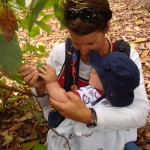
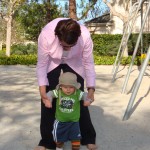
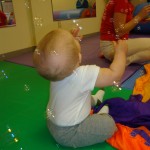
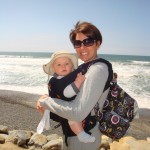
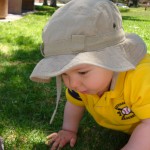
Play: 4 to 6 Months
Play starts getting more fun since your baby is more alert and begins to become an explorer and investigator versus a passive play mate. At this age, baby starts to move too and, from here on out, won’t stop!
A 4 to 6 month old baby is quite a charmer! He loves to smile, make silly noises at you (or anyone for that matter), to babble, and starts using his voice to get a reaction! This is also the time when physical development gets “rolling” at an amazing rate. Baby begins to prop sit (with arms or support), push up more on arms in tummy time and begins to roll purposefully. Reaching becomes more and more accurate since eye hand coordination has improved. Baby will reach for anything (ask any older sibling) and likely put most any object into his mouth to explore it. Moving an object from one hand to the next will soon follow. Around this time, most babies begin to sleep better so parents get to come back from the land of Sleep Deprivation (even if it’s short-lived). With so many big changes, how can you maximize your play with this amazing little one? Below are a few ideas organized by thinking of baby’s senses!
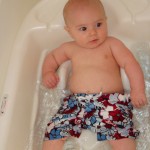
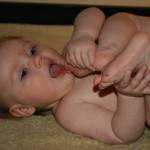
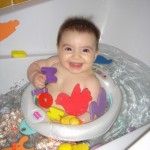
Touch: Baby will love to experience different textures on his hands, face, and body. Try introducing toys, blankets, stuffed animals with different textures. Try putting on simple white gloves and washing your baby at bath time. It provides a different sensation and helps you hold on to a slippery baby! Continue with naked baby time and body exploration. Try playing games like “where are your toes?” and then touch his toes (either with your hands or his) and say “Toes!”
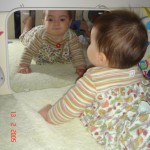
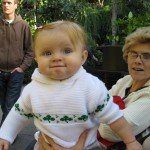
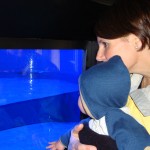
Sight: Baby is ready to check out all of the new colors he can now see. He now distinguishes between new and familiar faces which may mean a bit more clinginess to his primary caregiver. Make sure you point out things and talk about the environment surrounding him, encouraging exploration by holding him up on your shoulder. Mirror Play in a variety of positions (tummy, supported sitting) to let him see himself is always fun. Try “Baby, Do What I do!” Make various facial expressions (open mouth wide, puff cheeks out, stick out tongue) and see if he tries to imitate you. Peek-a-boo is a great game to play with you, siblings, toys, etc. Baby will need help initially but, pretty soon, he will have this tricky game all figured out!
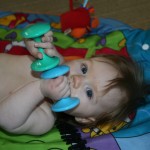



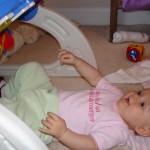
Sound: Rattles, maracas, and very simple cause and effect toys (with your help initially) will be quite fun for baby. Shake a rattle behind your baby’s head and let him or her turn and grab it. Baby still loves YOU the best so use your voice! Make silly sounds and mimic his sounds . . . the sillier the better! One of the cutest things I get to see these days are baby and his older brother “talking”! Make sounds for your baby. Clap your hands (help him clap his too because this will happen very soon) and help baby bang two objects together. Play music too. What about “zerberts”? Isn’t blowing on your baby’s chubby baby tummy the best? In our house, that crazy sound always gets a laugh! Remember, many sounds in the environment will be new and novel like a dog barking, bell ringing, music, etc. so be respectful!
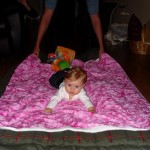

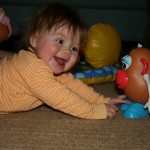
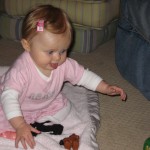

Movement: Dance with baby. Hold your baby in different ways (tucked in front, tummy, side) than your standard and dance away, sing, smile – in front of a mirror is even better! Or, make it a movement activity for the entire family! Always check on baby every 30 to 60 seconds by “freezing” or “waiting.” This gives your little one a break to let him process the new information and reset himself in a way. Give baby plenty of time on the floor each day. I know this can be difficult but this floor time is one of the most essential parts of development. It is the perfect surface and the perfect time for baby to spend time on his tummy, back, supported sitting, rocking on hands and knees all to build strength and skill to progress toward rolling, crawling, and walking. As this stage progresses, try and have baby equal time on all four sides of the body.
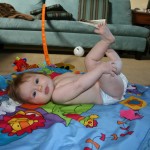
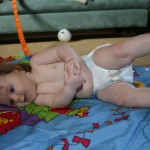
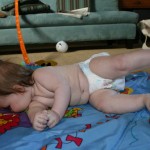
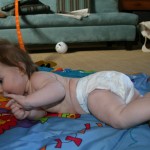

Other Helpful Hints: To help your baby focus, put out only one or two toys at a time. Be respectful of all that baby is learning and balance stimulation with plenty of quiet time. And, of course, be respectful of baby’s cues that he needs space or a break. Can you imagine having to learn so many things in such a short time? So many things are new as they move, PLAY, and grow!
Enjoy the magic and the wonder!
Play: 2 to 4 Months
Continuing with the play theme, your 2 to 4 month old baby is definitely more alert, more interactive, and more interested in initiating exploring his world. You just need to give yourself permission to linger, to observe and to marvel. It will still take a while for him to organize purposeful movements, sounds, smiles, and coos, but if you linger it will happen. And then you will be addicted and do everything in your power to see him do it again!
A 2 to 3 month baby smiles and coos, holds his head more steadily in midline, and controls gross shoulder movements to reach his arm in space towards something interesting. His favorite toy is still YOU, but you can also introduce bold colored or simply patterned books or toys (or safe Christmas ornaments). His gross reach into space will be more like a punch with a closed fist (no controlled grasp with hand yet), but when his hands are closer to his body and face or on an object, they will open and scratch at the surfaces.
I caught my husband playing with Kellan on the changing table, giving and receiving “body blows” with right and left jabs and hooks. I LOVED seeing this because Neil entered Kellan’s world. He observed what Kellan was doing and gave meaning to it. Kellan’s blows knocked Neil a few paces backwards or to the side, and with every repetition, Kellan understood more and more that his movements were affecting his environment. He was in control! Smiles and coos followed. No laughs yet, but we are waiting to hear Kellan’s first giggle!
A 3 to 4 month baby definitely exhibits more control, keeping body symmetrical right and left, top to bottom. Reaching is more refined and, when body is supported, head control is great with very little wobbling! This all translates into more refined play. Baby will turn his head to your voice, follow you with his eyes, reach for and briefly grasp objects. Expect more cooing and smiling. And his favorite toy…..YOU! Faces fascinate baby, but if you need to step away, try placing baby near a mirror so he can see himself!
Babies at this time are busy exploring all that they see. Because head control is greatly improved, eyes have the opportunity to fix themselves on different objects to study them. You will find baby staring at you and if in the right position, different parts of his own body (which he considers to be completely separate from himself). Though he can’t yet do it by himself, if you bring his feet into view, he will study them like they are the most amazing phenomena ever. This often elicits gross reaching and swiping at them. Self-discovery is so important, and this age is a perfect one to start “naked playtime.” Take his clothes and diaper off and in a warm room on a blanket or floor mat, place him on back, tummy and side and let him move around and explore in the buff. He will get his hand-to-hand, hand-to-chest, hand-to-face/head/mouth. If your house is just too cold, linger a little longer in the bathtub for the same experience.


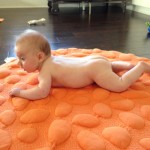

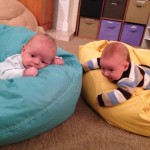
Other ideas include music and singing, starting peer time in playgroups (babies LOVE other babies…and it’s a great time for moms/dads to get together), reading (never to early for this), and lingering with the daily tasks. Your play will come naturally if you really observe your baby, enter his world and help him make sense of it. Be respectful of his needs and follow his cues, whether he wants more intense sensory experiences or to calm down a bit. Sometimes it can be a challenge to read your baby and know what they need, but through daily play and interaction, you will continue to know your little guy and love him that much more!
What are some of your favorite play activities at this age?
Play: Newborn 0 to 2 months
Once established that your newborn baby (0-2months) is in an active-alert, ready to learn, ready to play state, what on earth are you supposed to do with her!?!?! In a one word answer, LOVE her! Touch her, hold and hug her, cuddle with her, sing to her, whisper sweet nothings, give LOTS of kisses all over. But…let’s also be realistic. Newborn babies are not awake that often, and when they are they are usually eating, pooping, burping, spitting up, being changed and/or bathed, changed again, and changed again. Is there time for all this LOVE? YES! Because the love happens during all the awake duties. Don’t think about it being extra, think of it as being a part of each task. Love is a journey, not a destination!
So, slow down, don’t rush through all the tasks, take time to observe and interact with your baby during all of it. Changing at our house routinely takes 15-30 minutes because of all the play on the table. Before you know it, playtime is over and it’s nap time again! And, please, though we all know that moms and dads are super-heros, try to take a nap when your baby sleeps. These first several weeks are often about survival, especially when up many times during the night. We also know if this isn’t possible…but give yourself permission and try :-). Always good to shoot for the stars, and have someone ELSE clean the house, do laundry and make dinner too :-).
Extra ideas to play with your newborn:
– Sing nursery rhyme songs or recite rhyming poems (from memory, refresh, or learn new ones).
– Talk about what you are doing at that moment in time, or tell a story about what happened during day or the plans for rest of day. Get VERY detailed. It will take a long time!
– Observe your baby’s facial expressions and copy them. Especially the mouth/lips/tongue. You will be amazed at what your baby can “say” to you through her mouth and you will start to learn so much about her.
– Read books and show pictures, black and white work best, but you can throw in some red too. Start with simple pictures and slowly get more detailed.
– Move slowly as you work around baby so she has a chance to see and track you from side to side with her eyes.
– Tummy time!! Near and dear to our hearts at Move Play Grow. Try chest to chest with you propped up closer to vertical than horizontal at this age. OR get down on floor and lay next to your baby about 10 inches away so she can see you best.
– Wear your baby and go for a walk to get out.
– Be quiet and still. Being awake, babies are taking in even the most mundane things that we take for granted. No need to over stimulate by shaking rattles and toys in their faces, moving and bouncing all the time. Allow some “down” time too.
– Mix it up.
Most importantly, get to know your baby: observe, learn, internalize, journal (write stuff down…you think you will remember everything, but you won’t), and love her. There is NO ONE else in the world like your baby and definitely NOTHING like the unique relationship you have with her. Cherish it!
A Big 2012 Thank You
As the end of the year approaches, we wanted to wrap up by letting you know just how much our little Move Play Grow endeavor has grown . . . in more ways than one! The first Tummy Time Class was held in April 2011, one time per month. The growth in 2012 is something of which we are proud of and excited to share. Here are some highlights:
We hosted over a dozen Tummy to Play Everyday Classes at multiple locations and multiple times per month. We enjoyed a partnership with Babies in Bloom (Vista), finally became part of the education series through Parent Connections (classes to begin January 2013), and now offer Saturday classes in Solana Beach.
Throughout the Spring and Summer, we spoke at 3 different FREE parent education workshops (JW Tumbles Carmel Valley, El Camino Pediatrics) as well as were featured speakers at a San Diego Birth Network meeting.
In June, Move Play Grow was born and a special website and Facebook Page dedicated to baby wellness launched. We have had so much fun adding information to both on a variety of topics.
The Move Play Grow Family literally grew by two as well! In July, we welcomed Rachel’s son, Colton, and in October, Wendi’s son, Kellan. These boys are new inspiration to us as we strive to get the message of baby wellness, bonding, and development out to so many expecting moms, new parents, seasoned parents, caregivers, pediatricians, etc.
In November and December, we worked hard to provide comprehensive Facebook posts and blogs on surviving the holidays, how to help your child through the season, and, introduced the beginnings of our series/course on Buy This/Not That: navigating the big box stores, online retailers, to find the best for your baby!
*** Most importantly, a sincere, heartfelt THANK YOU to all of the families, followers, partners, and friends that we have had the pleasure of working with over this past year . . . whether at one of our classes, through our blog, or Facebook posts. If you like what you see, don’t forget to click “like” or “share” on Facebook! If you have things you would like to learn about, etc., PLEASE let us know in the comments section, via email, etc! This entire endeavor is for YOU – to support you and your family. Stay tuned to learn how we will be Moving, Playing, and Growing in 2013!!
Happy New Year! ~ Wendi and Rachel
Buy This: All About Timing
Timing of gifts are as important as the gift itself. The ages stated on toys are both for safety and for children’s cognitive abilities. Buy one too early and you might frustrate your child; buy one too late and they’ll be bored. This is another reason to purchase toys that appeal to all ages, inspire creativity and imagination, and can be played with differently as your child grows and matures. This post discusses Stacking Cups and Push Toys.
A toys that works at most ages: Stacking Cups
– 4-6 months: watch parent spin them on floor, reach for them as grasp emerges, mouth them
– 6-7 months: Bang two together with one in each hand
– 7-8 months: Passing single cup hand to hand
– 10 months: Container to put things in
– 12-14months: Rolled on floor, picked up from floor, playing hide and seek for the cup, using as a container to put things in AND dump them out
– 15-17 months: Stacking
– 17+: Stacking higher and higher and KNOCKING it over in fun, novel ways :-), sorting, more complex games! Watch your child play with them to give you ideas how to jump in, join THEIR world and help expand it.
A toy that should be delayed before introduced: Push Toy
A push toy often has 12 months of age associated with it, but that is assuming your child is walking. A push toy should NOT be introduced before your child is walking independently. Many people believe that it can be a walking aide that teaches a child to walk. In fact, it encourages movement compensations that impede independent walking and encourages taking forward steps with heavy leaning on hands. Walking with a push toy before independent walking is also a safety hazard because the child cannot control the speed or direction of the toy, which can get away from them. Their protective extension (arms forward to break a fall) is not yet fast enough to always help them catch their inevitable fall.
However, once a child is walking well, push toys are FABULOUS! Small grocery carts can be filled and emptied and transported place to place. Parents can make the cart heavy by placing gallon cartons filled with water into the basket (or allowing kids to use many small water bottles so they can do the heavy lifting), requiring stronger pushing and pulling. Obstacle courses can be set up to steer in, out and around, encouraging problem solving with the inevitable crashes (and, unbelievably, providing a foundation for prepositions in language!). It is also a great core workout–just think how much your abs need to work to steer those wayward grocery carts in the store! And of course, it allows your little one to do a “mommy/daddy” job and trains them for using the “customer in training” carts at the stores!
Timing is key when first introducing toys. Appropriate expectations for play will help you to make smarter selections. Kids are always drawn to novel things, so rotating toys every few weeks will rekindle interest in old toys and give you an opportunity to see how they approach their toys differently. Ultimately, engage with them in the play: first observe what they are doing, join in to be with them in the moment and then help them expand OR be amazed as they push YOUR limits!
Have fun! Play lots! Be SILLY!
Guest Post: YOU are the BEST Toy
Christmas is nearly here! Soon, you and your little ones will likely be knee deep in toys, wrapping paper, and fun! As we bring our Buy This/Not That Series to a close, we have a guest post from a wonderful speech and language therapist. In this special post, Miss Lori reminds us all of something very important, a message that can carry us throughout the years.
When thinking about what toys to pick for your child, keep in mind that it is not the toy itself but what YOU do with it that brings the magic to the play. Ultimately YOU are the best toy for your child. From the very beginning stages of development, it is the relationship YOU create with your child that supports the development of his or her creative mind. YOU bring the play to life whether cradling your baby in your arms, banging on a pot with him while singing your favorite tune, or all dressed up as a princess in her favorite castle. IT is YOU that helps your child make connections, build experiences and help get the ideas flowing. With time, you will start to see your child bring in their own ideas from their own experiences and begin the process of thinking, learning and creating.
Here are just a few ideas for toys/household items that will facilitate the fun, creative play above:
Infant: Laundry basket, Books, Stackers/nesters, any time/anything that supports face to face interactions with your child! Get down and view the world from their eyes!
Toddler: Pots/Pans, Hats, Buckets/Balls, Bubbles, Bowls, Beads, Blankets, YOU!
Preschool: Tents, Puppets, Plush Toys, Boxes, Dress Up (be creative with what you have!), YOU!
Embrace the magic of your child and see the world through their eyes! Thank You Miss Lori for this reminder!
By: Lori Jenkinson, SLP-CCC
Buy This…If You Can: The Changing Table Challenge
This title takes on many meanings. From a baby that does not like being placed on his back, getting dressed or undressed, to the wiggle worm who just cant seem to be still enough to get business done, to the balancing game of whether to dodge or catch pee, poop and spit up! Changing can really be a challenge.
But today we are going to focus on the actual table. My sister had the first baby in our family, in Belgium. I went to visit and the MOST fun place to play with baby was on the changing table. It was oriented so that the head was up, feet were down and the “changer” was standing at baby’s feet. There were necessary items logically placed and within reach and baby followed my every move, looking back and forth, up and down as I went about the business of cleaning, diapering and donning clothes.
After the business was done, we stayed to play. I played peekaboo using her feet, I watched her facial expressions and mimicked them, utterly enthralled when she engaged in a true “conversation,” and I watched with awe as she tried to organize volitional movements with her head, arms and legs. A diaper change that can last as little as a couple minutes turned into a 20 minute play time session. It was wonderful!
Fast forward 2 years when I became pregnant and went searching for my changing table. Much to my dismay, there was not ONE SINGLE TABLE in the United States that was oriented with baby’s head up. ALL of them were sideways, designed for “changers” to stand at baby’s side. I finally found one from a manufacturer that is now out of business (see photos). It is a separate top that bolts onto the dresser and into the wall for safety. It then folds out or back when you need to have easier access to the top drawer.
Why is this important? When you stand at baby’s feet, you are encouraging symmetry, with baby looking down at you (downward visual gaze). As you move about, baby looks left and right and back to center again, practicing holding midline positions. Standing at his feet, you notice asymmetries in baby’s head/neck and body, whether they are tilted left or right or resisting looking one way or the other. Because baby is on an elevated surface rather than on the floor, it’s better on your body and therefore easier to engage baby in conversation. In addition,using a flat pad rather than one with a trough and raised sides allows baby to roll sideways rather than blocking movement.
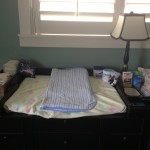
By contrast, on US-designed tables, babies are typically positioned head to our left or right with little alteration. You are looking sideways at baby’s body and baby is always looking sideways at you. Given that we are very one-side-dominant adults, we tend to have a preference for which side we like to approach, so we don’t often change the way baby faces. Also, it’s tough to place your baby’s head on the spot his bottom was a few hours before. These changing tables facilitate asymmetry and imbalance, and if you do not engage in the switching which side baby’s head is on, baby is overdeveloping one side at the expense of the other.
I would LOVE to say “Buy This,” but I cannot find it! The challenge, therefore, is to FIND a changing table manufactured in the US that allows us to change at baby’s feet and is wide enough to safely allow movement side to side. I’m searching for a company that OR a person (who might want to start a company). Please, share your knowledge! Many babies and families will be thankful!
Buy This: Baby Proofing Services or Items
Though the general theme for our pro/con equipment recommendations is “less is better” in order to allow for more independent, self-driven exploration and development, the first priority is always safety.
Babies are little scientists and will explore every nook and cranny. Once they start rolling and crawling to get from place to place, your cute little blob that could be placed on a mat before can now not be out of your immediate sight, lest they get into some sort of trouble. This is when containers look really attractive, because we are exhausted supervising every second and cannot possibly be within arm’s reach all day long. BUT, rather than spending money on these devices that restrict movement, create a safe place where baby can explore. A large play yard is a start, but soon baby will want to explore his house! The entire house! And he will find his favorite spots, usually the most dangerous ones you never knew you had! This is where baby-proofing your house is essential. There are many do-it-yourself guides and products, but it might be worth having professionals come in and help to identify the risky areas you never knew you had.
In Greater San Diego area, Baby Safe Homes is a great company that comes in and performs an evaluation/inspection and installation (should you choose) the same day. Disclaimer: Move Play Grow has no financial ties to Baby Safe Homes, but I personally used them to baby proof our house and they were wonderful!
So, whether you choose to perform this task yourself or to outsource it, baby proofing BEFORE your baby becomes mobile is essential. Most accidents that occur with babies are preventable. Thoughtfully making your house safer will help relieve your anxiety about allowing baby to be the scientist he really wants to be!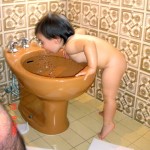
Be Happy! Be Safe! Be Explorers!
Buy This…Not That: Play Table vs. Jumper
BUY THIS: Play Table
This type of toy is fairly new on the scene. I had one for my son and loved it. Even though it does have quite a few cause/effect buttons, sounds, etc. which can be overwhelming at times, I look past that due to the versatility of it! Below are three common uses:
1.) Legs Off/Flat on Ground. This is great for babies 2 to 6 months. Baby can activate it during tummy time, once he learns how to weight shift, and can also easily push buttons when sitting independently. Always make sure you supervise your little one as baby will likely bonk his face into the table during tummy time or tumble forward if a new sitter! If your baby is not yet sitting independently, you can provide assistance by supporting/putting your hands on the trunk. The lower your hands are, the harder he will have to work!
2.) Table with legs on/All 4 sides accessible: Your baby is ready for this around 9 to 12 months – when they start standing with minimal support and cruising. When baby is just starting to stand, he will likely lean on the table quite a bit so wedge the table in a corner (like between couch/wall) to prevent table and baby from toppling over! Baby will become more skilled at pull to stand and more controlled when squatting to sit back down. Eventually, you may notice a step or two to each side – that’s the beginning of cruising!
3.) Table Placed near another surface (couch): Your baby will likely be ready for this around 10 to 12 months. This may likely be the first time you see your little daredevil attempt to take steps on his own to reach the other surface. Creating safe opportunities to transfer between surfaces (especially YOU!) and allows your baby to build more and more confidence to eventually let go and step where he desires to go!
Although they may come with a few too many bells and whistles, these play tables meet other requirements to make it a great toy to have as your baby grows: can be played with in multiple positions, can be played with in multiple ways, appeals to many senses, etc. Look for them on Craigslist, garage sales, or baby resale shops too. Most parents won’t realize how versatile these tables are and you can score a great bargain! Check out the other creative ideas in this link and always remember to supervise AND PLAY with your little one during these play table activity times!
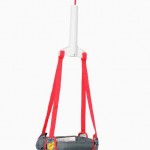 . . . NOT THAT: Doorway Jumpers
. . . NOT THAT: Doorway Jumpers
These jumpers look like so much fun and many parents think it is a great way for baby to exercise and gain strength in their legs. Although the American Academy of Pediatrics does not take a stance on the use of jumpers, the Consumer Products Safety Commission has banned many jumpers for design flaws.
Consider the following for your baby:
*The primary reason to avoid: RISK OF INJURY. Babies often jump too forcefully and hit their heads on the doorways or, even worse, cause the apparatus to come dislodged and crashing down. There are also other physical and developmental reasons why we recommend choosing a different product.
*Babies are often placed in them before they are truly excellent independent sitters causing baby to hang in the sling seat. This puts undue stress on their hips. Because babies tend to jump forcefully in these things they do not learn slow controlled movements needed for walking. These jumpers do nothing to develop strength in the core and leg muscles for balance and walking since the movements are fast and ballistic instead of slow and controlled. And, since baby is supported, there is no need to use any type of protective or balance reactions as would be needed in the beginning stages of standing and walking.
There are better choices out there! If you really need a place to “put” your baby, consider the old fashioned “play pen” (pack and play) or simple floor time where they can reach for objects, roll, creep and crawl!
